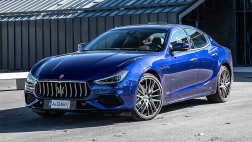The Shelby Cobra of the 1960s spectacularly blends a small British roadster with a gutsy American heart, but there’s another reason why this open-top muscle car is remembered so fondly, and is so very desired by collectors.
Carroll Shelby had many successes in his career, not the least of which his victory at the 24 Hours of Le Mans endurance race in 1959.
However, health conditions soon shifted Shelby’s focus away from racing, and the budding entrepreneur looked to realise his dream of building his very own sports car.
.jpg)
In 1961, Shelby heard that English company AC Cars was to stop production of its Ace, a small, two-door model with an English six-cylinder engine.
Mr Shelby figured that the little British roadster could really benefit from a powerful American V8, and so he had an AC Ace body sent to his workshop in California, and with help from Ford Motor Company, began developing a model of his own.
In 1962, the Shelby Cobra was released in the United States. At first, the Cobra drew power from a 4.3-litre Ford V8, although that motor was soon replaced by Ford’s more powerful 4.7-litre unit.
Despite its strong performance, with the lightweight and nimble chassis from AC, and the grunt and reliability of a Ford V8 engine, Carroll Shelby decided to up the ante in 1964 with the monstrous Shelby Cobra 427.
The Shelby Cobra 427 was longer and wider than its predecessor, and received a number of chassis and suspension improvements to cope with its much larger 305kW/650Nm 7.0-litre V8.
With the new donk, the Cobra 427 was considerably faster, but by most accounts a difficult machine to steer, even in competent hands, and like a maniacal bull for unseasoned drivers.
.jpg)
For those that could tame the beast, the Shelby Cobra 427 was one of the quickest models on offer at the time, capable of sprinting from zero to 100km/h in under five seconds.
As the story goes, Carroll Shelby would cheekily place a $100 note on the Cobra 427’s dash and wager that anyone who could reach it during acceleration could keep it.
It’s reported that just 348 Shelby Cobra 427 units were ever built, but many were crashed and destroyed due to its unwieldy nature.
Even rarer are models equipped with the power boosting ‘Competition’ package designed for racing, or with the ‘Semi-Competition’ package for owners that wanted a road-ready vehicle that could also be raced on occasion.
.jpg)
A genuine Shelby Cobra 427 is extremely hard to come by, with one example selling at auction last year for $US1.8 million.
A few years prior, the first-ever Shelby Cobra sold for a staggering $US13.7 million.
Because of the rarity of the Shelby Cobra, a number of companies have produced replicas over the years, which can be purchased relatively inexpensively due to the simplicity of the platform.
Carroll Shelby passed away in 2012, though his legacy lives on with a number of high-performance vehicles carrying his name.
In fact, the recently revealed Ford Mustang Shelby GT500 is said to be the fastest, most powerful production Mustang ever produced.





.jpg)
.jpg)


.jpg)



.jpg)



.jpg)







